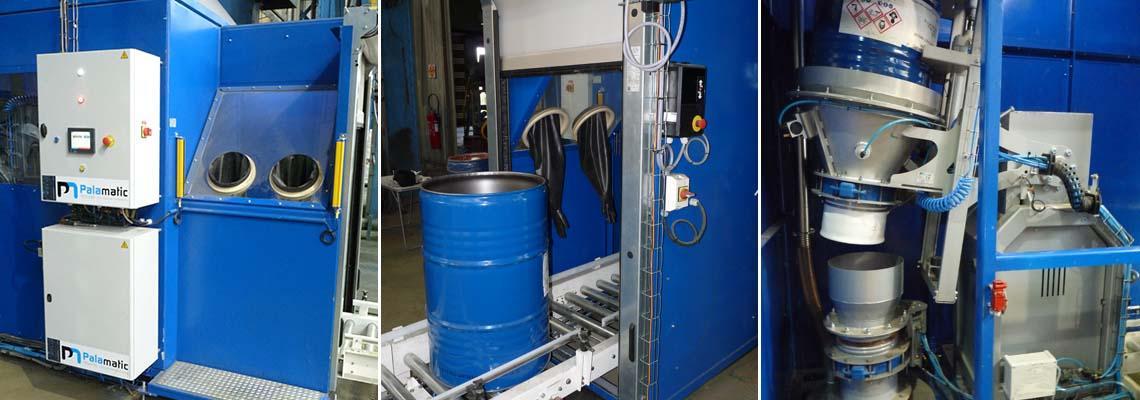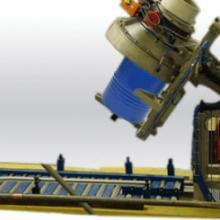Processed powder: sodium methylate
Contained discharge of chemical powder
Objective: Safely unload drums containing sodium methylate in a Class 1 / Division 2 hazardous environment and avoid operator exposure to the material.
The client is a manufacturer of toners, pigments and powder coatings in the chemical industry. As part of their production process, they receive crystallized sodium methylate in 55-gallon drums with plastic liners. Current method of unloading these drums is via a suction wand that tends to have problems with clogging. The client is looking for a more automated unloading system that can increase the input rates over the current method.
The Solution - DrumFlow® 04
The Drumflow®04 drum tipping system allows total containment of bulk materials and powders during the unloading operation. The primary method of containment is the unique drum capping mechanism that fits around the inlet of the drum. The docking cone surrounds the outside of the drum to contain and funnel the material through the drum tipper’s cone outlet. Bars attached to the inside of the docking cone prevent the internal drum liner from turning over during the tilting operation.
The automation sequence involves the following steps:
- The mechanical roller conveyor transfers the filled drum from the staging area to the docking station.
- The drum docking cone is lowered over the drum to cap it, and the loading tray below the drum helps lift and cradle it, locking it in place. The internal bars / forks help prevent the inner liner from falling out during the unloading operation.
- The lifting tray and docking cone flip the drum upside down.
- The outlet of the cone is an inflatable seal that docks with the inlet to the downstream process. The seal inflates to contain any potential dust and a butterfly valve releases the material for full discharge.
Due to the toxicity of our customer’s product, our team of experts designed an enclosed station to avoid any operator exposure to the product during the unloading cycle.
In order to safely uncap the lids, the bulk material container is placed on a motorized conveyor and transferred into a glove box station that is sealed via an automatic access door. An inflatable seal is used around the contact edges of the door to reinforce the enclosed system.
The operator, positioned behind plexiglass, opens the drum via the glovebox.
Once the drum is uncapped, the operator presses a button to start the roller conveyor transfer to the tipping station for unloading of the bulk materials (sodium methylate).
Operating Procedure
The entire drum tipper is installed inside a contained safety enclosure which can prevent the automated cycle from starting if any access doors are in the open position. For further protection from material exposure, the enclosure can be connected to a dust collection unit. Options for an integrated dust filtration system are available.
The drums are placed directly on the tipping plate by means of a roller conveyor (gravity or motorized options available). Positioning end-stops are provided and once the sensors are engaged, the operator can start the tilting cycle.
The connection cycle consists of positioning the barrel inside the capping cone. A butterfly valve is placed at the outlet of the capping cone. Once the drum if flipped 180°, holding bars attached to the cone penetrate the drum in order to prevent the inner liner from falling with the product.
The tilting cycle consists of rotating the drum and connection cone assembly with the product chute. This tilting is conducted via a gearbox motor.
The product chute outlet is completely vertical at the end of the tipping operation.
Two possible sealing systems are available:
- A socket joint, located on the inlet port of the downstream bulk material buffer hopper.
- An inflatable seal on the outlet tube that covers the downstream inlet. Once inflated, the seal provides containment around the inlet pipe of the buffer hopper.
Once the drum is emptied, the tipping assembly returns back to its initial start position. An optional push cylinder allows the empty drum to be evacuated to a conveyor for removal from the system.
The system controls are provided by Palamatic Process. The client selected for this particular project Allen-Bradley CompactLogic with ethernet communication. Other options such as Siemens and Schneider Electric are available.
Since 1992, Palamatic Process has provided equipment to over 2000+ installations in over 30 countries. We offer knowledge and expertise in all manner of powder and bulk automated material handling needs. Examples include, pneumatic conveyors, screw conveyors, turnkey solutions, bulk bag filling, bulk bag unloading, bulk material handling, powder processing equipment, food-grade design, etc.
Contact one of our experts today for assistance with your material handling solutions, or to request a quote.















